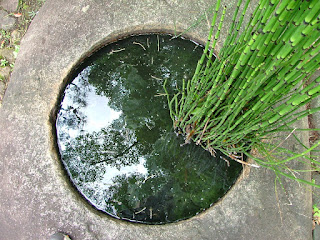I wrote out, in Japanese, how to say "Today, where do I buy a disposable camera?" I'm pretty sure I got it write since we've been practicing using question words, verbs, and nouns in sentences. So, I walk up to Sensei, clutching my cheat sheet, and say "Sensei, kiyo doko de disposable kamera o kaimasu ka." She responded with "Sogo o kaimasu." which surprised me because I've been in Sogo and it is a very high-end expensive department store. The kind of place where I'm afraid to touch anything with my greasy fingers for fear some smartly dressed salesperson will make me now purchase what I dared to defile. Not the kind of place you buy a disposable camera. She then said "Quinn-san, doko de kasa o kaimashita ka." She was asking me where I bought my parasol. I answered and, before I could repeat my question, she asked me wear I bought my shirt. And then she held up her necklace and prompted me to ask her where she bought her necklace. It finally dawned on me that she thought I wanted to practice and was not asking an actual question. I shook my head and simply said "kiyo disposable kamera doko" today disposable camera where. Thanks to my utter disregard for what she's been teaching us, she finally figured out I was actually asking her a question. She then provided an accurate answer and I found disposable cameras.
This morning, while walking to the train station, I exclaimed "Wow" and then a second later "oh." Craig burst out laughing because he knew exactly what I was talking about. I can't remember if I've mentioned it, but I've gotten into the bad habit of talking about the people around me. I'm operating under the assumption that they don't understand me because I don't understand them. In tight places, like elevators, I confirm if they in fact don't understand, before saying anything about them, by adding, mid whatever sentence I'm saying at the time, "snake." If they turn their head I figure they understand English. If they don't, I'm safe. Generally it is things like - "Look at those shoes, they're super cute" or "put a mask on it" if someone coughs in my vicinity. Sometimes "Is that a boy or a girl?" as they are walking directly past me - the guys here are very androgynous. I bet you're wondering what made me go "wow." Well, you know how, on average, Japanese women are very tiny and lack curves. I saw serious cleavage for the first time since we got here. The "oh" was when I realized the woman was a gaijin, not Japanese. She was wearing sunglasses and had very dark hair so I had to get a better look at her facial features before I knew she wasn't a Japanese woman who had plastic surgery. Hopefully she doesn't understand English but "wow" and "oh" are pretty universal. Of course, if she's wearing what she was wearing, she was probably pleased with the "wow." In America, however, her cleavage wouldn't have been noteworthy. Craig thinks it would have been.
I made okonomiyaki tonight! It was as delicious as it looks. It's the Japanese style pancake I mentioned needing the egg for in an earlier post. It has flour, water, egg, cabbage, green onion, chicken, okonomiyaki sauce, seaweed flakes, bonito (dried fish shavings) and love in it.


After dinner, I heard crying in the hall. At first I figured it was a kid crying to her/his mother while walking down the hall past our front window. It didn't subside after a few minutes so I took a look outside. There was this elementary school aged boy pacing back and forth crying. I asked "daijobu ka" ok? He looks up at me with tears streaming down his face and starts telling me something in Japanese. I immediately called for Craig. Craig repeated the question and the boy once again started telling us his woes. He figured out pretty quickly we had no idea what he was saying and started walking away from us, still crying. Luckily, just at that moment a woman got off the elevator and took over. We felt utterly powerless.
































